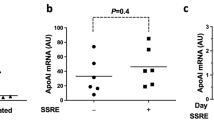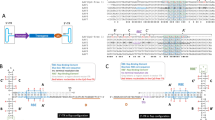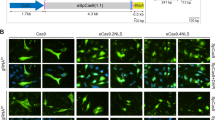Abstract
One factor limiting the success of non-viral gene therapy vectors is the relative inability to target genes specifically to a desired cell type. To address this limitation, we have begun to develop cell-specific vectors whose specificity is at the level of the nuclear import of the plasmid DNA. We have recently shown that nuclear import of plasmid DNA is a sequence-specific event, requiring the SV40 enhancer, a region known to bind to a number of general transcription factors (Dean DA, Exp Cell Res 1997; 230: 293). From these studies we developed a model whereby transcription factor(s) bind to the DNA in the cytoplasm to create a protein–DNA complex that can enter the nucleus using the protein import machinery. Our model predicts that by using DNA elements containing binding sites for transcription factors expressed in unique cell types, we should be able to create plasmids that target to the nucleus in a cell-specific manner. Using the promoter from the smooth muscle gamma actin (SMGA) gene whose expression is limited to smooth muscle cells, we have created a series of reporter plasmids that are expressed selectively in smooth muscle cells. Moreover, when injected into the cytoplasm, plasmids containing portions of the SMGA promoter localize to the nucleus of smooth muscle cells, but remain cytoplasmic in fibroblasts and CV1 cells. In contrast, a similar plasmid carrying the SV40 enhancer is transported into the nuclei of all cell types tested. Nuclear import of the SMGA promoter-containing plasmids could be achieved when the smooth muscle specific transcription factor SRF was expressed in stably transfected CV1 cells, supporting our model for the nuclear import of plasmids. Finally, these nuclear targeting sequences were also able to promote increased gene expression in liposome- and polycation-transfected non-dividing cells in a cell-specific manner, similar to their nuclear import activity. These results provide proof of principle for the development of cell-specific non-viral vectors for any desired cell type.
This is a preview of subscription content, access via your institution
Access options
Subscribe to this journal
Receive 12 print issues and online access
$259.00 per year
only $21.58 per issue
Buy this article
- Purchase on Springer Link
- Instant access to full article PDF
Prices may be subject to local taxes which are calculated during checkout







Similar content being viewed by others
References
Dean DA . Import of plasmid DNA into the nucleus is sequence specific Exp Cell Res 1997 230: 293–302
Nigg EA . Nucleocytoplasmic transport: signals, mechanisms and regulation Nature 1997 386: 779–787
Dowty ME et al. Plasmid DNA entry into postmitotic nuclei of primary rat myotubes Proc Natl Acad Sci USA 1995 92: 4572–4576.
Hagstrom JE et al. Nuclear import of DNA in digitonin-permeabilized cells J Cell Sci 1997 110: 2323–2331
Sebestyén MG et al. DNA vector chemistry: the covalent attachment of signal peptides to plasmid DNA Nature Biotech 1998 16: 80–85
Dean DA, Dean BS, Muller S, Smith LC . Sequence requirements for plasmid DNA nuclear entry (Submitted for publication)
Kovacs AM, Zimmer WE . Cell specific transcription of the smooth muscle γ-actin gene requires both positive and negative acting cis-elements Gene Exp 1998 7: 115–129
Zimmer WE, Browning C, Kovacs AM . Cell-specific regulation of the SMGA gene Dev Biol 1996 175: 399 (Abstr.)
Shimizu RT et al. The smooth muscle α-actin gene promoter is differentially regulated in smooth muscle versus non-smooth muscle cells J Biol Chem 1995 270: 7631–7643
Kallmeier R, Somasundaram C, Babji P . A novel smooth muscle enhancer regulates transcription of the smooth muscle myosin heavy chain gene in vascular smooth muscle cells J Biol Chem 1995 270: 30949–30957
Herring B, Smith A . Telokin expression is mediated by a smooth muscle specific promoter Am J Physiol 1996 270: C1656–C1665
Li L, Miano J, Mercer B, Olson E . Expression of the SM22 α promoter in transgenic mice provides evidence for distinct transcriptional regulatory programs in vascular and visceral smooth muscle cells J Cell Biol 1996 132: 849–859
Samaha F et al. Developmental pattern of expression and genomic organization of the calponin-hi gene J Biol Chem 1996 271: 395–403
Miwa T et al. Structure, chromosome location, and expression of the human smooth muscle (enteric type) gamma-actin gene: evolution of six human actin genes Mol Cell Biol 1991 11: 3296–3306
Szucsick J, Lessard J . Cloning and sequence analysis of the mouse smooth muscle γ-enteric actin gene Genomics 1995 28: 154–162
Browning CL et al. The developmentally regulated expression of serum response factor plays a key role in the control of smooth muscle-specific genes Dev Biol 1998 194: 18–37
Treisman R . Ternary complex factors: growth factor regulated transcriptional activators Curr Opin Genet Dev 1994 4: 96–101
Browning C, Zimmer WE . Multiple trans-acting factors bind with promoter elements of the smooth muscle γ-actin gene to regulate cell specific transcription (Submitted for publication)
Langle-Rouault F et al. Up to 100-fold increase of apparent gene expression in the presence of Epstein–Barr virus oriP sequences and EBNA1: implications of the nuclear import of plasmids J Virol 1998 72: 6181–6185
von Schwedler U, Kornbluth RS, Trono D . The nuclear localization signal of the matrix protein of human immunodeficiency virus type 1 allows the establishment of infection in macrophages and quiescent T lymphocytes Proc Natl Acad Sci USA 1994 91: 6992–6996
Bukrinsky MI et al. Active nuclear import of human immunodeficiency virus type 1 preintegration complexes Proc Natl Acad Sci USA 1992 89: 6580–6584
Bukrinsky MI et al. A nuclear localization signal within HIV-1 matrix protein that governs infection of non-dividing cells Nature 1993 365: 666–669
Kann M, Bischof A, Gerlich WH . In vitro model for the nuclear transport of the hepadnavirus genome J Virol 1997 71: 1310–1316.
Greber UF, Kasamatsu H . Nuclear targeting of SV40 and adenovirus Trends Cell Biol 1996 6: 189–195
Nakanishi A et al. Association with capsid proteins promotes nuclear targeting of simian virus 40 Proc Natl Acad Sci USA 1996 93: 96–100
Collas P, Husebye H, Alestrom P . The nuclear localization sequence of the SV40 T antigen promotes transgene uptake and expression in zebrafish embryo nuclei Transgenic Res 1996 5: 451–458
Collas P, Alestrom P . Rapid targeting of plasmid DNA to zebrafish embryo nuclei by the nuclear localization signal of SV40 T antigen Mol Mar Biol Biotechnol 1997 6: 48–58
Pelligrini L, Tan S, Richmond TJ . Structure of serum response factor core bound to DNA Nature 1995 376: 490–498
Gauthier-Rouvière C et al. The serum response factor nuclear localization signal: general implications for cyclic AMP-dependent protein kinase activity in control of nuclear localization Mol Cell Biol 1995 15: 433–444
Walther C, Gruss P . Pax-6, a murine paired box gene, is expressed in the developing CNS Development 1991 113: 1435–1449
Mansouri A, Stoykova A, Gruss P . Pax genes in development J Cell Sci Suppl 1994 18 (Suppl.): 35–42
Moser M et al. Cloning and characterization of a second AP-2 transcription factor: AP-2β Development 1995 121: 2779–2788
Orlic D, Anderson S, Nishikawa S-I, Nienhuis AW . Gene expression in purified murine hematopoietic stem cells Blood 1992 80: 245a
Kovacs AM, Zimmer WE . Molecular cloning and expression of the chicken smooth muscle γ-actin mRNA Cell Mot Cytoskel 1993 24: 67–81
Chen CY et al. Activation of the cardiac α-actin promoter depends upon serum response factor, tinman homologue, NKx-2.5, and intact serum response elements Dev Genet 1996 19: 119–130
Croissant JD et al. Avian serum response factor expression restricted primarily to muscle specific lineages is required for α-actin gene transcription Dev Biol 1996 177: 250–264
Dean DA, Li PL, Lee LM, Kasamatsu H . Essential role of the Vp2 and Vp3 DNA-binding domain in SV40 morphogenesis J Virol 1995 69: 1115–1121
Cambell GR, Chamley JH, Burnstock G . Development of smooth muscle cells in tissue culture J Anat 1974 117: 295–312
Hayward LJ, Schwartz RJ . Sequential expression of chicken actin genes during myogenesis J Cell Biol 1986 102: 1485–1493
Johnson CV, Singer RH, Lawrence JB . Fluorescent detection of nuclear RNA and DNA: implications for genome organization Meth Cell Biol 1991 35: 73–99
Acknowledgements
We thank Curtis Browning and Ileana Aragon for establishing and culturing the chicken embryo fibroblasts and smooth muscle cell cultures, Dr Adrienne Kovacs for the SMGA promoter/CAT constructs, and Dr Paul Babal for providing us with cultures of human smooth muscle cells and for helpful discussions. Supported in part by grants ALG 960006 (DAD) from the Alabama Affiliate of the American Heart Association, 9404341 (WEZ) from the USDA, and R01 HL59956–01 (DAD) and 5P60 HL38639 (DAD and WEZ) from the NIHLB.
Author information
Authors and Affiliations
Rights and permissions
About this article
Cite this article
Vacik, J., Dean, B., Zimmer, W. et al. Cell-specific nuclear import of plasmid DNA. Gene Ther 6, 1006–1014 (1999). https://doi.org/10.1038/sj.gt.3300924
Received:
Accepted:
Published:
Issue Date:
DOI: https://doi.org/10.1038/sj.gt.3300924
Keywords
This article is cited by
-
New-Generation Benzimidazole-Based Plasmid Delivery Reagents with High Transfection Efficiencies on the Mammalian Cells
In Vitro Cellular & Developmental Biology - Animal (2020)
-
EBNA1-targeted probe for the imaging and growth inhibition of tumours associated with the Epstein–Barr virus
Nature Biomedical Engineering (2017)
-
Advanced Design of Dumbbell-shaped Genetic Minimal Vectors Improves Non-coding and Coding RNA Expression
Molecular Therapy (2016)
-
Identification of an alveolar type I epithelial cell-specific DNA nuclear import sequence for gene delivery
Gene Therapy (2016)
-
Electroporation-mediated delivery of the FER gene in the resolution of trauma-related fatal pneumonia
Gene Therapy (2016)



